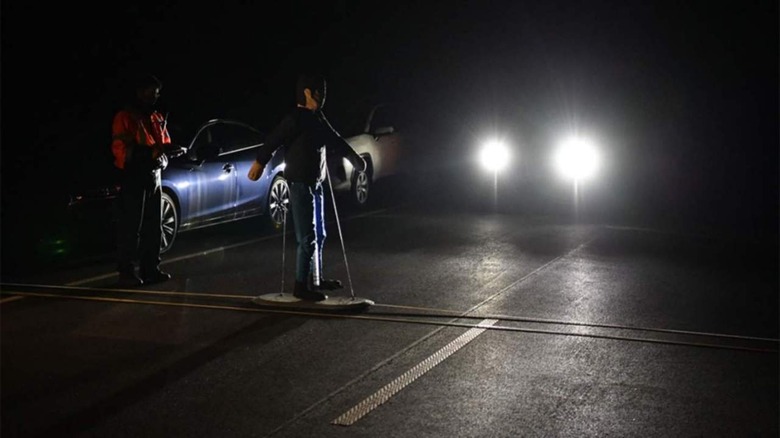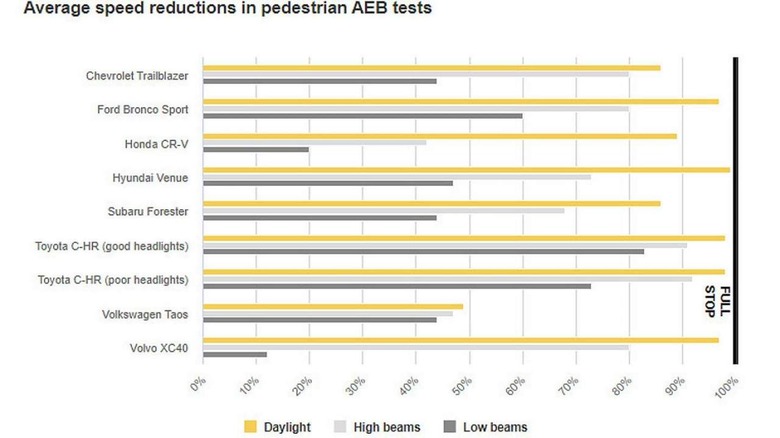Tougher Auto-Braking Test May Send Automakers Back To The Drawing Board
The Insurance Institute for Highway Safety (IIHS) is a non-profit that has been developing crash testing regimens for cars since it opened its Vehicle Research Center in 1992. The organization's rating system has become widely relied upon by consumers while also forcing car manufacturers to raise the bar when it comes to the crashworthiness of their vehicles. Based on its latest crash research, this time into automatic emergency braking (AEB) systems, it looks like automakers may be forced to go back to the drawing board.
Modern AEB systems are designed to protect pedestrians and prevent rear-end collisions by applying the brakes, when necessary, without driver intervention. Analyzing real-world crash data from nearly 1,500 police-reported vehicle crashes involving 2017-2020 model year vehicles, the IIHS researchers found that in all driving conditions, AEB systems reduced pedestrian crash rates of all severities by 27%.
However, when the team parsed the data for nighttime crashes on roads without street lights, cars fitted with AEB systems performed no better than cars that lacked the technology.
AEB performance nosedives at night
According to the IIHS, its decision to limit "Top Safety Pick" and "Top Safety Pick+" awards to models that feature vehicle-to-pedestrian crash prevention tech led to this safety feature's adoption across the industry. The organization now plans to add a nighttime testing element to its suite of AEB crash assessments, and doing so may have the same effect.
In a statement about the organization's findings, the study's first author Jessica Chicchino, IIHS VP of research, explained:
This is the first real-world study of pedestrian AEB to cover a broad range of manufacturers, and it proves the technology is eliminating crashes. Unfortunately, it also shows these systems are much less effective in the dark, where three-quarters of fatal pedestrian crashes happen.
Crashes between cars and pedestrians in the U.S. have been on the rise. According to the National Highway Traffic Safety Administration (NHTSA), 6,205 pedestrians were killed in traffic crashes in 2019. The IIHS says this represents an alarming 51% increase in pedestrian fatalities on an annual basis since 2009.
The problem for AEB systems — at least based on the IIHS findings — is that most pedestrian fatalities occur at night between the hours of 5:30 PM and 11 PM. This means these systems are least effective when they're most needed, potentially putting an asterisk next to an automaker's claims regarding the efficacy of their AEB systems.
Newer cars are better, but improvement is needed
Following its analysis of the real-world crash data, the IIHS conducted additional nighttime evaluations of AEB systems found on several SUV models, including the 2019 Subaru Forester, 2019 Volvo XC40, 2020 Honda CR-V, 2020 Hyundai Venue, 2021 Chevrolet Trailblazer, 2021 Toyota C-HR, 2022 Volkswagen Taos, and 2021 Ford Bronco Sport.
The selected vehicles offered a mix of AEB systems, including ones that used a single camera, a dual camera, a single camera plus radar, and radar only. As expected, the overall AEB performance generally declined in nighttime testing conditions, which included the use of low and high beam headlights. Among other things, the researchers found headlight quality had a noticeable impact on the results.
With that said, the IIHS found that some of the new models it tested did show signs of nighttime performance improvements. The organization hopes that adding a new nighttime AEB element to the next version of its crash assessment suite will similarly push the automotive industry to improve this technology.


